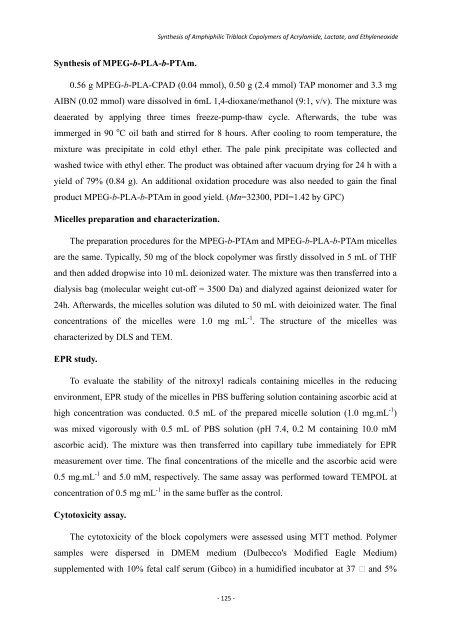Catalytic Synthesis and Characterization of Biodegradable ...
Catalytic Synthesis and Characterization of Biodegradable ...
Catalytic Synthesis and Characterization of Biodegradable ...
You also want an ePaper? Increase the reach of your titles
YUMPU automatically turns print PDFs into web optimized ePapers that Google loves.
<strong>Synthesis</strong> <strong>of</strong> MPEG-b-PLA-b-PTAm.<br />
<strong>Synthesis</strong> <strong>of</strong> Amphiphilic Triblock Copolymers <strong>of</strong> Acrylamide, Lactate, <strong>and</strong> Ethyleneoxide<br />
0.56 g MPEG-b-PLA-CPAD (0.04 mmol), 0.50 g (2.4 mmol) TAP monomer <strong>and</strong> 3.3 mg<br />
AIBN (0.02 mmol) ware dissolved in 6mL 1,4-dioxane/methanol (9:1, v/v). The mixture was<br />
deaerated by applying three times freeze-pump-thaw cycle. Afterwards, the tube was<br />
immerged in 90 o C oil bath <strong>and</strong> stirred for 8 hours. After cooling to room temperature, the<br />
mixture was precipitate in cold ethyl ether. The pale pink precipitate was collected <strong>and</strong><br />
washed twice with ethyl ether. The product was obtained after vacuum drying for 24 h with a<br />
yield <strong>of</strong> 79% (0.84 g). An additional oxidation procedure was also needed to gain the final<br />
product MPEG-b-PLA-b-PTAm in good yield. (Mn=32300, PDI=1.42 by GPC)<br />
Micelles preparation <strong>and</strong> characterization.<br />
The preparation procedures for the MPEG-b-PTAm <strong>and</strong> MPEG-b-PLA-b-PTAm micelles<br />
are the same. Typically, 50 mg <strong>of</strong> the block copolymer was firstly dissolved in 5 mL <strong>of</strong> THF<br />
<strong>and</strong> then added dropwise into 10 mL deionized water. The mixture was then transferred into a<br />
dialysis bag (molecular weight cut-<strong>of</strong>f = 3500 Da) <strong>and</strong> dialyzed against deionized water for<br />
24h. Afterwards, the micelles solution was diluted to 50 mL with deioinized water. The final<br />
concentrations <strong>of</strong> the micelles were 1.0 mg mL -1 . The structure <strong>of</strong> the micelles was<br />
characterized by DLS <strong>and</strong> TEM.<br />
EPR study.<br />
To evaluate the stability <strong>of</strong> the nitroxyl radicals containing micelles in the reducing<br />
environment, EPR study <strong>of</strong> the micelles in PBS buffering solution containing ascorbic acid at<br />
high concentration was conducted. 0.5 mL <strong>of</strong> the prepared micelle solution (1.0 mg.mL -1 )<br />
was mixed vigorously with 0.5 mL <strong>of</strong> PBS solution (pH 7.4, 0.2 M containing 10.0 mM<br />
ascorbic acid). The mixture was then transferred into capillary tube immediately for EPR<br />
measurement over time. The final concentrations <strong>of</strong> the micelle <strong>and</strong> the ascorbic acid were<br />
0.5 mg.mL -1 <strong>and</strong> 5.0 mM, respectively. The same assay was performed toward TEMPOL at<br />
concentration <strong>of</strong> 0.5 mg mL -1 in the same buffer as the control.<br />
Cytotoxicity assay.<br />
The cytotoxicity <strong>of</strong> the block copolymers were assessed using MTT method. Polymer<br />
samples were dispersed in DMEM medium (Dulbecco's Modified Eagle Medium)<br />
supplemented with 10% fetal calf serum (Gibco) in a humidified incubator at 37 <strong>and</strong> 5%<br />
‐ 125 ‐

















